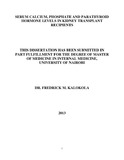| dc.description.abstract | Background
Successful renal transplantation corrects the abnormalities of mineral metabolism that lead to
mineral bone disease. This includes correction of uremia, normalization of serum calcium and
phosphorus levels, and restoration of calcitriol production. However, the degree of renal function
recovery is usually incomplete, and persistence of hyperparathyroidism is common. In addition,
the immunosuppressive drugs used to prevent graft rejection exert profound effects on bone
metabolism. Disturbances of mineral metabolism and skeletal problems are common causes of
morbidity and have been associated with cardiovascular risk after kidney transplantation.
Objective of the study
To determine the levels of serum calcium, phosphate and parathyroid hormone levels among
kidney transplant recipients attending clinic at Kenyatta National Hospital.
Methodology
A cross-sectional study was carried out among 85 renal transplant recipients who were at leas
t 6 months post transplant consecutively recruited for over a period of 5 months. At the time of
recruitment demographic data, duration of dialysis, time since transplantation and etiology of
kidney disease were entered into study performa. Blood was drawn and measurements of serum
creatinine, calcium, phosphorus and albumin levels were determined using automated clinical
chemistry analyzer. Serum intact parathyroid hormone (iPTH) assays were performed using
electro-chemiluminiscence immunoassay on the fully automated analyzer (Cobas 601). Patients
had their glomerular filtration rate estimated (eGFR) using Modified Diet in Renal Disease
(MDRD) formula and staged as per kidney disease outcome quality initiative (K/DOQI) criteria
Data management and analysis
Data analysis was performed using SPSS version 17.0 software. Characteristics of participants
were summarized into means/medians and proportions for continuous and categorical variables
respectively. Correlation between serum calcium, phosphate and parathyroid with estimated
glomerular filtration rate was measured using Pearson correlation coefficient. All statistical tests
9
were performed at 5% level of significance (95% confidence interval). The findings were
presented using tables and graphs.
Results
A total of 85 renal transplant recipients who were at least 6 months post transplant attending
transplant clinic at Kenyatta National Hospital were studied.
The study population was categorized into 5 groups as per K/DOQI staging of chronic kidney
disease. CKD stage 1T had 8 patients, stages 2T, 3T, 4T and 5T had 45, 28, 2 and 2 patients
respectively.
These 85 patients were on dialysis for an average of 12 months with a mean estimated
glomerular filtration rate of 64 ml/min/1.73m2.
The mean parathyroid hormone level was 38.1pg/ml with 20% of patients having
hyperparathyroidism and 16.5% having hypoparathyroidism. There was no significant
correlation between serum PTH and eGFR.
Hypocalcemia was found in 49.4% of patients and was associated with relatively younger
patients [age 37.5 (±11.5) years] compared to those with normal serum calcium levels [age 43.8
(±12.4) years] (p=0.017). No significant correlation was found between hypocalcemia and
eGFR. Majority of patients had normal serum phosphorus levels (92.9%).
Conclusion
This study demonstrated that hyperparathyroidism is still present even after successful kidney
transplantation. It appeared not be associated with duration of dialysis or graft function as it was
found in other populations.
Hypocalcemia as well as hypoparathyroidism are also common in the transplant population and
there seem to be no significant correlation with graft function though hypocalcemia was
significantly associated with younger patients. Majority of our patients had normal phosphorus
levels. | en_US |
| dc.description.department | a
Department of Psychiatry, University of Nairobi, ; bDepartment of Mental Health, School of Medicine,
Moi University, Eldoret, Kenya | |

